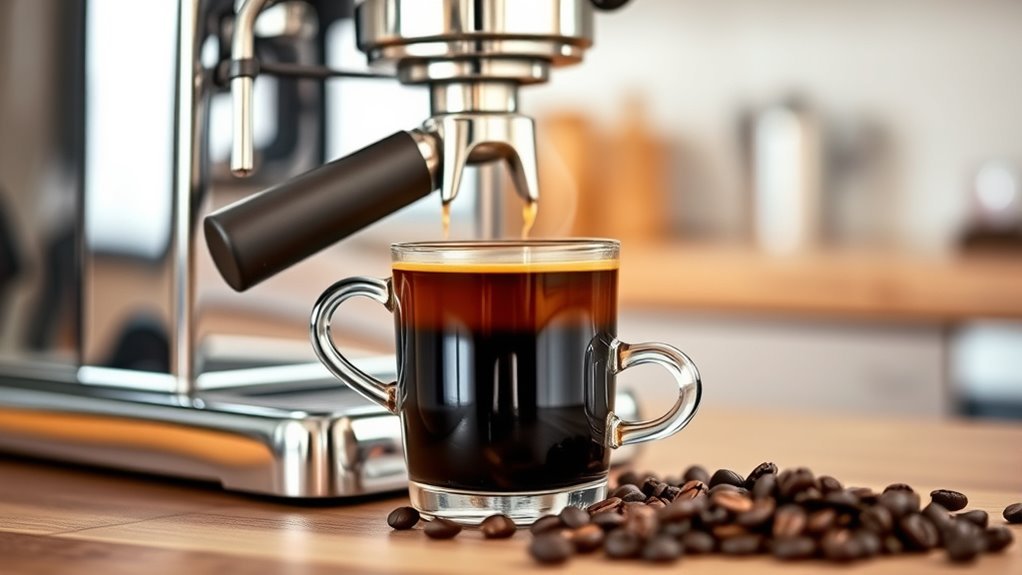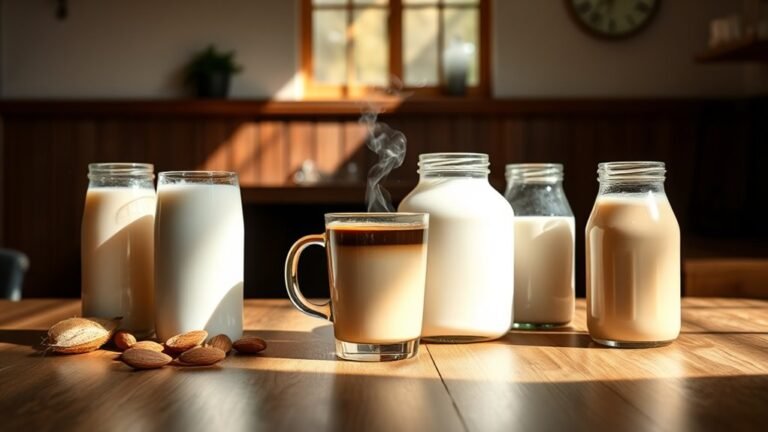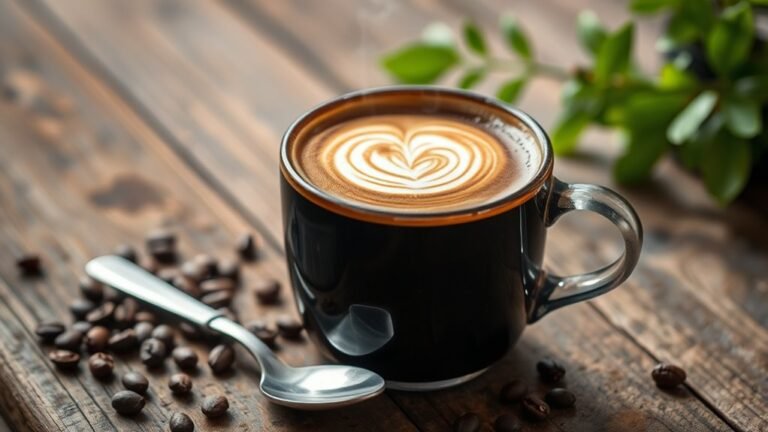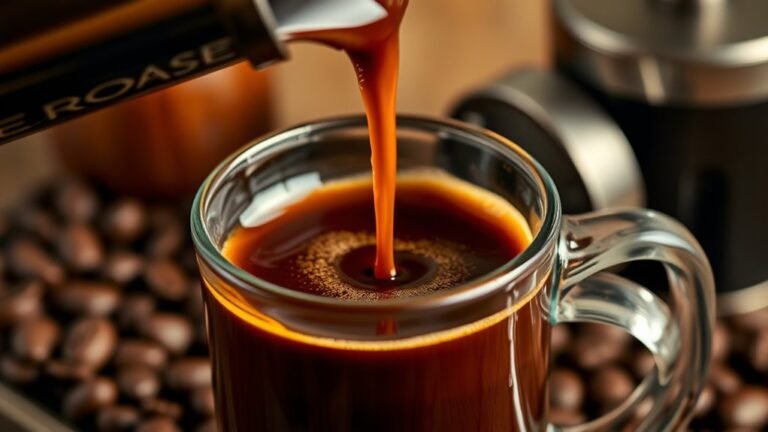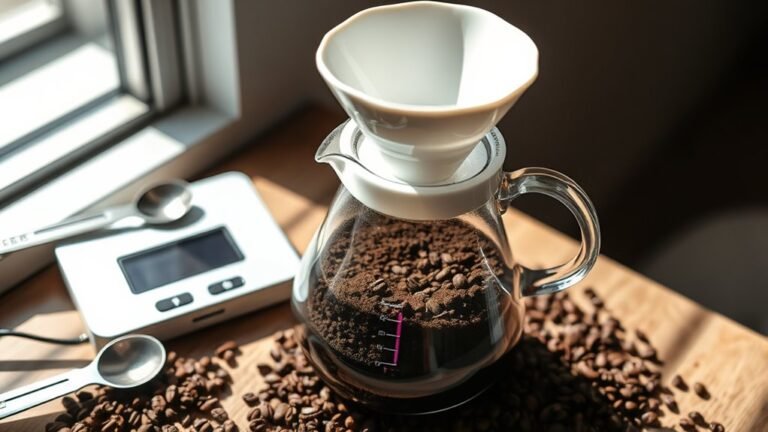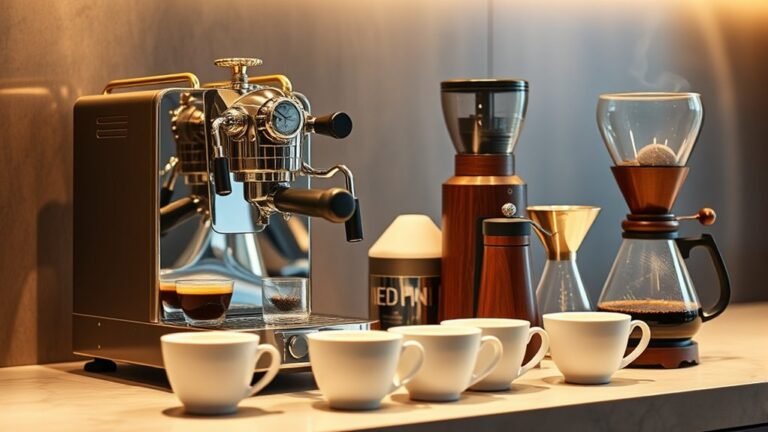Can You Make Regular Coffee With Espresso Machine
Yes, you can make regular coffee with an espresso machine by using specific techniques and adjustments. For instance, try brewing an Americano by adding hot water to espresso or a longer espresso shot for more volume. Adjust grind size and coffee doses, and experiment with coffee-to-water ratios for ideal flavor. Additionally, controlling water temperature and brewing time is essential for a balanced brew. Discover more insights on enhancing your coffee experience and maintaining your machine efficiently.
Understanding Espresso Machines
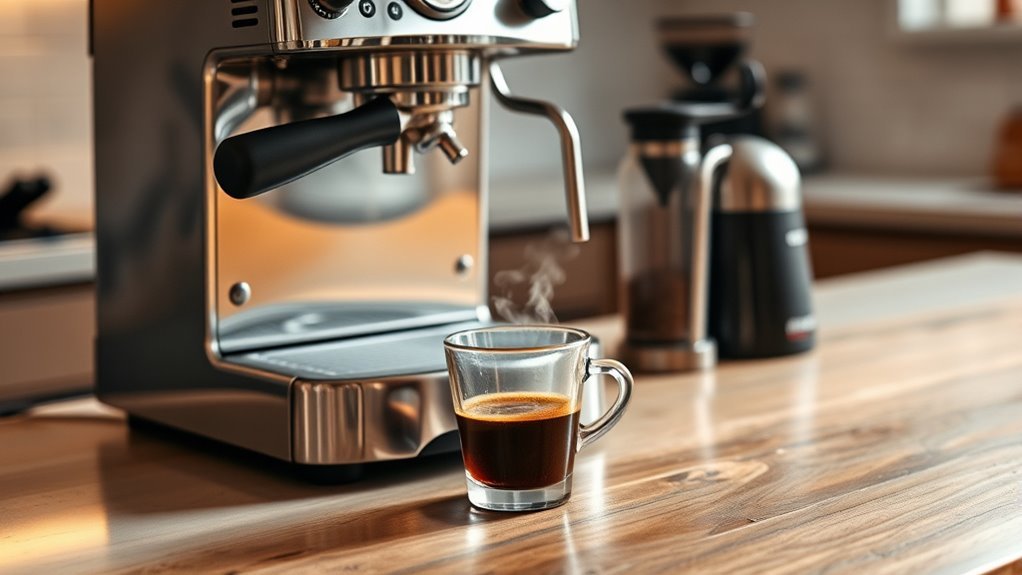
Espresso machines are the heart of many coffee enthusiasts’ kitchens, combining engineering and artistry to create rich, concentrated coffee. Understanding espresso machine types is vital for maximizing your brewing versatility. From manual to semi-automatic and fully automatic machines, each type offers unique features catering to different skill levels and preferences. Manual machines give you full control, allowing for a more personalized experience, while automatic options simplify the process, ensuring consistency with minimal effort. Additionally, some machines come with built-in grinders, enhancing convenience. Your choice will influence not just espresso but also other coffee styles, broadening your brewing options. Embracing this versatility empowers you to explore and enjoy a variety of coffee experiences tailored to your taste.
The Differences Between Espresso and Regular Coffee
When you compare espresso and regular coffee, you’ll notice significant differences in their brewing processes, flavor profiles, and caffeine content. Espresso is brewed quickly under high pressure, resulting in a concentrated shot that packs a punch, while regular coffee is typically brewed more slowly, allowing for a different extraction of flavors. Understanding these distinctions can enhance your appreciation of both styles and help you make better choices for your coffee experience.
Brewing Process Differences
Although both espresso and regular coffee share the same basic ingredients, the brewing processes that distinguish them are quite different. Understanding these differences can help you appreciate the art of coffee making.
- Espresso extraction occurs under high pressure, forcing hot water through finely-ground coffee in about 25-30 seconds.
- Regular coffee uses various brewing methods, such as drip or French press, which involve longer extraction times.
- The grind size for espresso is much finer than for regular coffee, affecting the outcome.
- Temperature and water-to-coffee ratios vary, with espresso requiring a precise balance for ideal flavor.
These factors create unique experiences in each cup, highlighting the versatility in how you can brew and enjoy your favorite caffeinated beverage.
Flavor Profile Variations
While both espresso and regular coffee originate from the same beans, their flavor profiles can vary considerably due to differences in preparation and extraction methods. Espresso boasts a higher flavor intensity, often showcasing rich, bold tasting notes like dark chocolate or caramel. The quick extraction process emphasizes these characteristics, producing a concentrated shot that can be both intense and complex. On the other hand, regular coffee typically has a milder flavor profile, allowing for a broader range of tasting notes, such as fruity or floral hints. The longer brewing time extracts oils and flavors differently, creating a smoother, more balanced cup. Understanding these variations can help you appreciate the unique qualities each method brings to your daily brew.
Caffeine Content Comparison
Understanding flavor profiles sets the stage for exploring caffeine content, as both aspects profoundly influence your coffee experience. While espresso and regular coffee come from the same caffeine sources, their caffeine content varies considerably based on serving sizes and preparation methods.
- Espresso typically contains about 63 mg of caffeine per 1-ounce shot.
- A standard 8-ounce cup of brewed coffee holds around 95 mg of caffeine.
- Due to the smaller serving size, espresso packs a punch in concentrated caffeine.
- Regular coffee offers a more balanced caffeine distribution across a larger volume.
When choosing between the two, consider how these differences in caffeine content align with your preferences and lifestyle. Whether you crave intensity or a milder buzz, understanding these nuances empowers your coffee journey.
Techniques for Brewing Regular Coffee
When brewing regular coffee with an espresso machine, understanding the variations in brewing methods is essential. You’ll want to pay attention to the coffee-to-water ratios, as they can greatly affect the flavor and strength of your brew. By experimenting with these factors, you can tailor your coffee experience to better suit your taste preferences.
Brewing Method Variations
Although many people associate espresso machines with brewing concentrated shots of coffee, they can also be versatile tools for making regular coffee through various techniques. Understanding these brewing method variations can help you tailor your coffee experience to your brewing preferences.
- Americano: Add hot water to a shot of espresso for a milder flavor.
- Long Espresso: Brew a longer shot, allowing more water to extract flavors, resulting in a larger volume.
- Espresso-Based Drip: Use the machine’s steam wand to create a drip coffee effect by cycling water through coffee grounds.
- French Press Adaptation: Use your espresso machine to heat water, then pour over coarsely ground coffee in a separate vessel for a full-bodied brew.
With these methods, you can exploit your machine’s versatility for a satisfying cup of regular coffee.
Coffee-to-Water Ratios
To brew a satisfying cup of regular coffee with your espresso machine, it’s essential to pay attention to the coffee-to-water ratio, as this balance greatly impacts flavor and strength. A common starting point is a 1:15 ratio—one part coffee to 15 parts water—though you can adjust based on your preference for coffee strength. Experimenting with these ratios allows you to achieve the brewing consistency that suits your taste. If you prefer a bolder cup, try a 1:12 ratio; for a lighter brew, go for 1:18. Remember, the key is to be adventurous and tweak the proportions until you find that perfect balance that resonates with your palate, making each cup an enjoyable experience.
Adjusting Grind Size and Coffee Dose
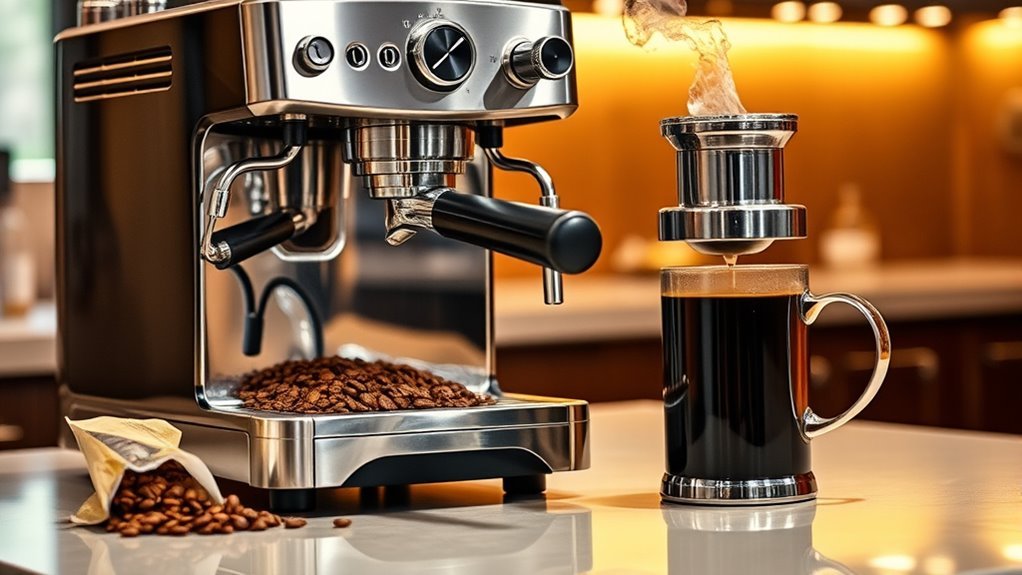
While crafting a regular cup of coffee with an espresso machine, adjusting the grind size and coffee dose is essential for achieving the desired flavor profile. The right grind consistency and accurate dose adjustments can transform your brew from ordinary to extraordinary.
- Experiment with a coarser grind for a more mellow flavor.
- Start with a dose of 10-15 grams for a standard cup.
- Test different grind sizes to find the sweet spot for your taste.
- Remember that small dose adjustments can markedly affect extraction.
Water Temperature and Brewing Time
Adjusting grind size and coffee dose sets the foundation for your brew, but water temperature and brewing time play pivotal roles in extracting the right flavors. The ideal water temperature for brewing coffee is between 195°F to 205°F. If it’s too hot, you might over-extract, leading to bitterness; too cool, and you risk under-extraction, resulting in sourness.
Brewing time typically ranges from 25 to 30 seconds for espresso, while regular coffee may require several minutes. Finding the sweet spot in brewing time is essential, as it allows the water to interact with the coffee grounds sufficiently. By mastering these elements, you’ll reveal a world of flavor possibilities, ensuring each cup you brew is a delightful experience.
Adding Flavor and Customizing Your Brew
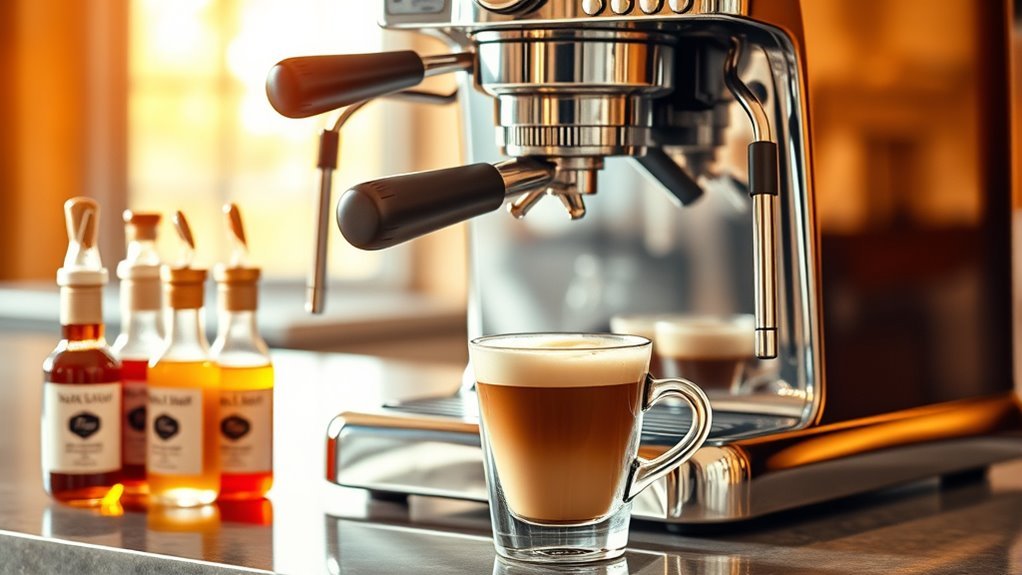
If you want to elevate your coffee experience, adding flavor and customizing your brew can make all the difference. With an espresso machine, you can easily experiment with flavor infusions and create personalized blends tailored to your taste. Here are some ideas to enhance your coffee:
Elevate your coffee experience by customizing flavors and creating personalized blends with your espresso machine.
- Syrups: Try vanilla, caramel, or hazelnut for a sweet twist.
- Spices: Cinnamon, nutmeg, or cocoa powder can add warmth and depth.
- Extracts: A few drops of almond or peppermint extract can transform your cup.
- Milk Variations: Use almond, oat, or coconut milk for unique creaminess.
Maintenance Tips for Your Espresso Machine
To keep your espresso machine functioning efficiently, regular maintenance is essential. By establishing a maintenance schedule, you’ll enhance your coffee experience and prolong your machine’s lifespan. Here are some effective cleaning techniques to take into account:
| Task | Frequency |
|---|---|
| Clean the portafilter | After every use |
| Descale the machine | Every 1-3 months |
| Wipe down exterior | Weekly |
Incorporating these tasks into your routine will prevent buildup that can affect flavor and performance. Remember, a well-maintained espresso machine not only serves better coffee but also gives you the freedom to experiment with your brew. So, embrace the care your machine deserves for best results!
Frequently Asked Questions
Can I Use Regular Coffee Grounds in an Espresso Machine?
You can technically use regular coffee grounds in an espresso machine, but it’s not recommended. Espresso machines are designed for finely ground coffee, which allows for ideal extraction under pressure. Regular coffee grind size might lead to poor espresso machine compatibility, resulting in weak flavor or blockages. If you’re craving a rich espresso, stick to the right grind. Experimenting can be fun, but for the best results, use espresso-specific coffee grounds.
Does Brewing Regular Coffee Take Longer With an Espresso Machine?
Imagine the aroma of coffee wafting through your kitchen as you brew your morning cup. When it comes to brewing regular coffee with an espresso machine, you might find that the brewing time can indeed differ. Typically, espresso is quick, extracting rich coffee strength in about 25-30 seconds, while a full pot of regular coffee might take several minutes. So, if you’re aiming for that classic drip experience, prepare for a longer wait.
Can I Brew Multiple Cups of Regular Coffee at Once?
When it comes to brewing multiple cups of coffee at once, your espresso machine may have limitations. While it’s designed for strong, concentrated shots, it typically brews one cup at a time. If you’re looking for a lighter brew, consider alternative brewing methods like a French press or drip coffee maker. These allow you to create larger quantities while controlling coffee strength, giving you the freedom to enjoy multiple cups without the hassle.
Is the Taste of Espresso Different From Regular Coffee Brewed This Way?
Absolutely, the taste of espresso differs from regular coffee due to its unique brewing technique. Espresso is crafted under pressure, extracting intense flavors and creating a rich, creamy texture. This process highlights the espresso flavor, often resulting in bold, concentrated notes that aren’t present in traditionally brewed coffee. If you’re seeking a different experience, experimenting with the espresso method can offer a delightful contrast, allowing you to explore new dimensions of your coffee journey.
What Espresso Machine Settings Are Best for Making Regular Coffee?
When using an espresso machine for regular coffee, adjusting the brew strength and grind size is essential. Opt for a coarser grind to mimic traditional drip coffee, and set the brew strength to a milder level. This will help extract the flavors without the intensity of a typical espresso shot. Experiment with these settings to find your perfect balance, allowing you the freedom to enjoy a smoother, more familiar coffee experience right from your espresso machine.
